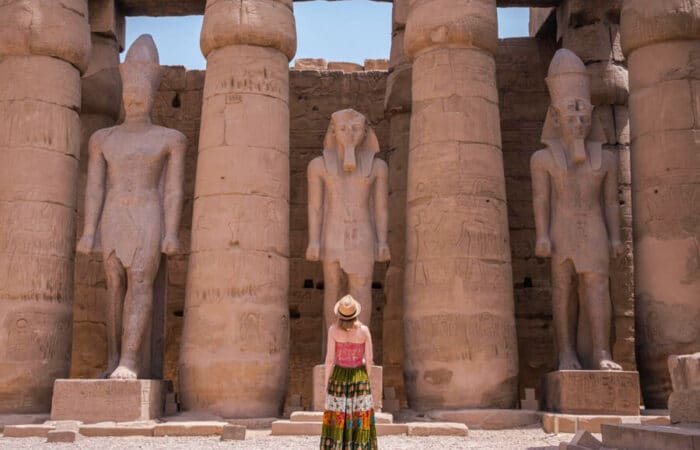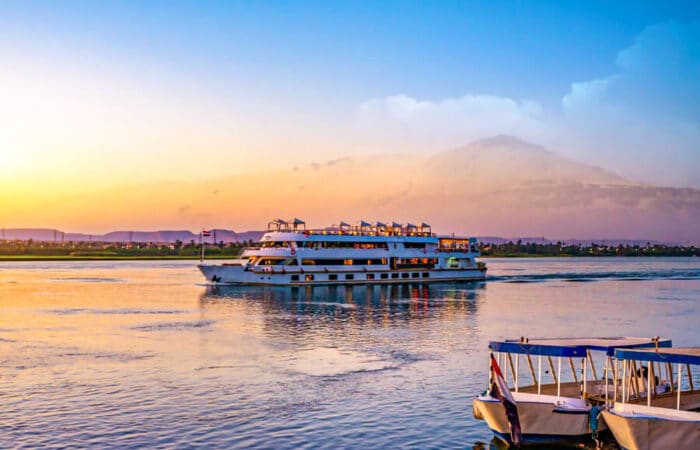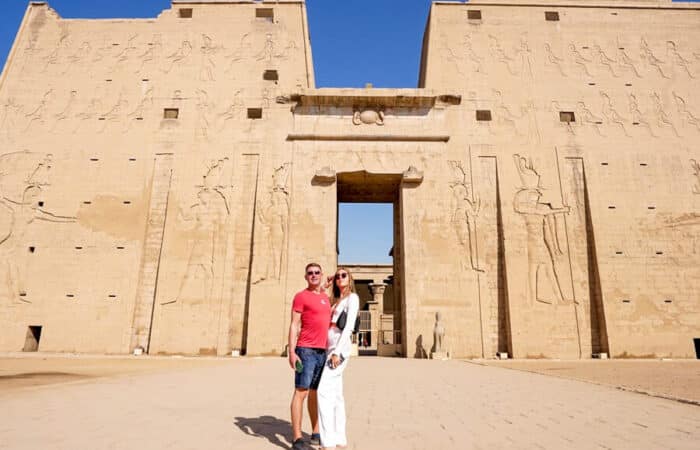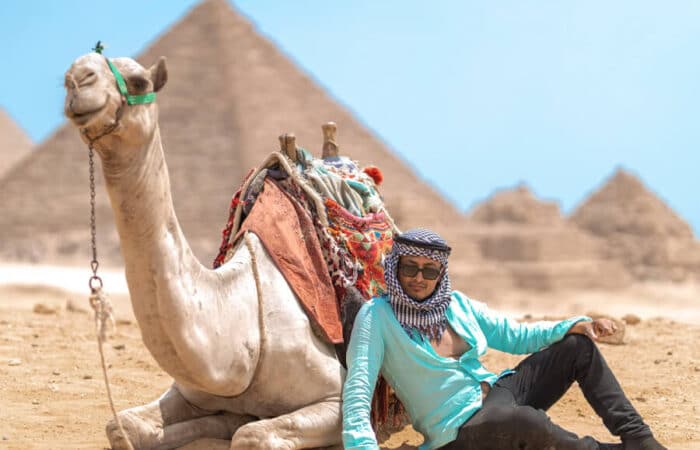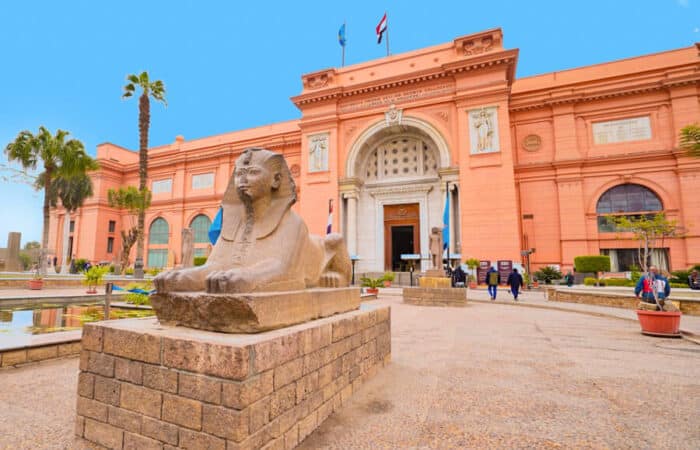Planning your dream trip to Egypt begins with a crucial question: When is the best time to visit Egypt?
The answer depends on what you want most—sun-soaked beaches, cooler sightseeing weather, bustling festivals, or budget-friendly deals.
As a local guide who’s helped travelers from all walks of life—families, solo adventurers, seniors, couples, and thrill-seekers—I can tell you there’s no one-size-fits-all answer. Egypt’s seasons each bring their charm, challenges, and travel perks.
In this guide, you’ll find:
- A month-by-month breakdown of Egypt’s weather and travel seasons
- Tips for the best months to visit Cairo, Luxor, the Nile, and the Red Sea
- Advice tailored for different traveler types—from cultural explorers to scuba divers
- Festival dates and local events to time your trip perfectly
- Insider packing and safety tips for every season
Whether you want to wander through the Pyramids of Giza without the crowds, cruise the Nile in mild winter sunshine, or dive into the coral-rich waters of the Red Sea, you’ll have all the info you need to plan your perfect Egyptian trip.
Understanding Travel Seasons: Egypt Weather by Month
Egypt’s magic changes with the seasons, and knowing what the best months to visit Egypt can make the difference between a good trip and an unforgettable one. Generally, Egypt has two main travel seasons—peak and low season—with shoulder months offering a sweet spot for certain travelers.
Peak Season (October – April)
- Weather: Mild and comfortable, perfect for sightseeing. Daytime temperatures range from 65–80°F (18–27°C), ideal for exploring ancient temples, tombs, and bustling souks without the oppressive heat.
- Atmosphere: Egypt is alive with visitors from around the world—popular sites like the Pyramids of Giza and Luxor’s Karnak Temple buzz with energy.
- Downside: Expect higher prices for hotels, tours, and flights. Booking is essential—especially during Christmas, New Year, and Easter.
Low Season (May – September)
- Weather: Hot, especially in Upper Egypt (Luxor, Aswan), where temperatures often exceed 100°F (38°C). The Red Sea coast is slightly cooler but still warm.
- Atmosphere: Quieter, slower-paced, and more relaxed. You’ll share sites with fewer tourists—sometimes having them almost to yourself.
- Upside: Lower travel costs, hotel discounts, and deals on Nile cruises. Ideal for budget travelers and those who don’t mind the heat.
Shoulder Seasons (Late September – Early October & Late April – Early May)
- Weather: Warm but more bearable than midsummer; perfect for beach lovers and desert adventurers.
- Best For: Travelers looking for a balance—fewer crowds, better prices, and good weather for both cultural exploration and coastal relaxation.
💡 Local Tip: The shoulder seasons are also when you can catch unique cultural events and enjoy a more authentic pace of life, as the crowds haven’t fully arrived or have just left.
Egypt’s Weather Patterns: A Crucial Factor
Egypt’s climate is as varied as its landscapes—from the lush Nile Valley to the desert and breezy Red Sea coast. While Egypt is warm and sunny year-round, the season and region you visit can drastically change your experience.
General Climate Overview
- Winter (December – February): Mild, sunny days (60–75°F / 16–24°C) and cooler evenings. Perfect for sightseeing, Nile cruises, and exploring ancient sites without breaking a sweat.
- Spring (March – May): Warm and pleasant, but watch for the Khamsin wind—a dry, dusty wind that can occasionally sweep across the country in April.
- Summer (June – August): Extremely hot, especially in Upper Egypt where temperatures can reach 105°F (40°C) or more. Best for budget travelers who stick to the cooler Red Sea coast.
- Fall (September – November): Comfortable and gradually cooling, with great conditions for both cultural exploration and coastal activities.
Regional Weather Differences
- Cairo & the Nile Valley: Hot, dry summers and mild winters. Winter highs hover around 70°F (21°C) while summer can soar above 95°F (35°C).
- Red Sea Coast (Hurghada, Sharm El Sheikh, Marsa Alam): More moderate temperatures year-round, making it ideal for diving and beach holidays even in summer.
- Western Desert & Oases (Siwa, Bahariya): Hot days and cool nights—pack layers if you’re heading into the desert.
Packing & Planning Around Weather
- For winter: Light layers for the day, warmer clothes for evenings.
- For summer: Breathable fabrics, sun protection, and plenty of hydration.
- Year-round: Comfortable walking shoes, a hat, and a reusable water bottle are essential for exploring Egypt’s historic sites.
💡 Local Tip: If you’re sensitive to heat, stick to early morning or late afternoon tours in summer, and consider booking accommodations with air conditioning or a pool.
| Month | Avg. Temp (°F) | Crowd Level | Best For | Local Tip |
|---|---|---|---|---|
| January | 65–72 | High | Sightseeing, Nile cruises | Book major sites early in the morning to avoid peak tour groups. |
| February | 66–75 | High | Cultural festivals, Abu Simbel Sun Festival | Great month for photography—clear skies & golden light. |
| March | 70–80 | Medium | Balanced weather, coastal trips | Be prepared for occasional Khamsin wind in April. |
| April | 75–85 | Medium | Desert adventures, diving | Mid-month crowds drop after Easter holidays. |
| May | 80–90 | Low | Budget travel, Red Sea beaches | Excellent time for diving before peak summer heat. |
| June | 90–100+ | Low | Diving, resort stays | Stay near the coast for cooler breezes. |
| July | 95–105+ | Low | Quiet cultural touring | Visit temples at sunrise to avoid the heat. |
| August | 95–105+ | Low | Diving, coastal relaxation | Hotels often have excellent summer discounts. |
| September | 85–95 | Medium | Desert treks, Red Sea trips | Shoulder season—good balance of price & weather. |
| October | 75–85 | High | Sightseeing, Nile cruises | Peak season begins—book tours & hotels in advance. |
| November | 70–80 | High | Cairo, Luxor, Aswan tours | Comfortable temps for all-day exploring. |
| December | 65–75 | High | Cultural sightseeing, festive season | Book early for Christmas/New Year availability. |

When to Visit Egypt’s Top Destinations
While Egypt’s overall travel seasons set the stage, the best and cheapest time to visit Egypt depends on the specific destinations you plan to explore. Each region offers a unique experience shaped by its climate, activities, and cultural highlights.
Cairo & Giza
- Best Time: November – February for cooler days and pleasant evenings. Daytime highs average around 70°F (21°C), perfect for wandering through the Pyramids and Sphinx without the blazing summer sun.
- Why Visit Then: Winter brings crisp skies for photography, a vibrant city atmosphere, and bustling markets like Khan El Khalili.
- Local Tip: If you visit in summer, start tours early in the morning to avoid midday heat and crowds.
Luxor & the Nile Valley
- Best Time: November – March when temperatures range between 60–80°F (16–27°C).
- Why Visit Then: Explore the Valley of the Kings, Karnak Temple, and Luxor Temple in comfort, without the intense summer heat. Nile cruises are especially enjoyable in winter with cooler breezes.
- Local Tip: The golden light at sunrise and sunset adds magic to your photos—plan your major temple visits around these times.
Aswan & Abu Simbel
- Best Time: October – April for mild weather and beautiful sunsets over the Nile.
- Why Visit Then: Enjoy relaxed felucca rides, the colorful Nubian villages, and the grandeur of Abu Simbel without scorching heat.
- Local Tip: Visit Abu Simbel during the Sun Festival in February or October for a unique alignment of sunlight into the temple’s inner sanctuary.
The Red Sea Riviera (Hurghada, Sharm El Sheikh, Marsa Alam)
- Best Time: October – May for water sports, diving, and snorkeling.
- Why Visit Then: Warm water temperatures (72–82°F / 22–28°C) and excellent underwater visibility make this a diver’s paradise.
- Local Tip: Summer can still be great for diving if you can handle the heat on land—just spend most of your time in the water.
Sinai Peninsula (Dahab, St. Catherine, Nuweiba)
- Best Time: November – March for hiking Mount Sinai and exploring Bedouin culture in mild conditions.
- Why Visit Then: Enjoy both beach relaxation and desert adventure in the same trip.
- Local Tip: If you plan to hike Mount Sinai, start before dawn to watch the sunrise from the summit.
💡 Traveler Match-Up:
- Families & Seniors: Winter for comfort and easier touring.
- Couples: Shoulder seasons for romance without the crowds.
- Solo Travelers & Budget Seekers: Low season for affordability and quieter experiences.
- Adventure Seekers: Spring and fall for hiking, diving, and desert exploration.
Exploring Egypt’s Coastal Regions
Egypt’s coastline isn’t just about beautiful beaches—it’s a meeting point of history, culture, and adventure. Whether you’re drawn to the desert-meets-sea landscapes of Sinai or the resort life of the Red Sea Riviera, knowing when to go can make all the difference.
Sinai Peninsula
- Best Time to Visit: November – March
- Why: Winter offers warm, dry days perfect for snorkeling in crystal-clear waters, hiking Mount Sinai, or wandering through colorful Bedouin markets.
- Top Activities:
- Dive into the vibrant coral reefs at Dahab and Nuweiba.
- Camp under a blanket of desert stars with Bedouin hosts.
- Trek through rugged mountain trails for panoramic Red Sea views.
- Local Tip: Early morning or late afternoon is best for outdoor hikes to avoid peak sun exposure.
Red Sea Riviera (Hurghada, Marsa Alam, El Gouna)
- Best Time to Visit: October – May
- Why: The weather is pleasantly warm with low humidity, perfect for water sports and beach relaxation. Water temperatures stay ideal for diving year-round, but spring and autumn offer peak visibility.
- Top Activities:
- Go kiteboarding or windsurfing in El Gouna.
- Take a liveaboard dive trip to explore shipwrecks and coral walls.
- Stroll along Hurghada’s marina for fresh seafood and lively nightlife.
- Local Tip: If you’re visiting in summer, book a sea-view hotel room for breezes and plan indoor activities during midday heat.
💡 Traveler Insight: While the Red Sea draws divers and luxury travelers, the Sinai Peninsula offers a more laid-back, adventurous vibe—perfect for those who want a mix of nature, culture, and serenity.

Egypt’s Cultural Events and Festivals
One of the most rewarding ways to experience Egypt is to time your visit with its vibrant cultural celebrations. From centuries-old religious traditions to colorful street festivals, these events offer a deep dive into the country’s heart and heritage.
Religious Celebrations
- Eid al-Fitr (dates vary each year): Marks the end of Ramadan with joyful family gatherings, festive street markets, and delicious traditional sweets. Expect a lively atmosphere but note that some shops and attractions may have reduced hours.
- Coptic Easter (usually April): Celebrated by Egypt’s Coptic Christian community with church processions, prayers, and shared feasts. The following day, Sham El-Nessim, sees families picnicking outdoors, flying kites, and enjoying salted fish.
Traditional Festivals
- Moulid of the Saints (various dates): Honoring Sufi saints with music, dancing, colorful lights, and sweet treats—an unforgettable sensory experience.
- Sham El-Nessim (day after Coptic Easter): A national holiday for Egyptians of all faiths, symbolizing the arrival of spring. Parks and riverbanks fill with families celebrating together.
Local Tip for Travelers
If you’re planning your trip during these festivals:
- Book accommodations early—both locals and tourists travel more during these periods.
- Be mindful of altered public transport schedules and site opening times.
- Bring a camera—you’ll find an explosion of colors, street scenes, and cultural moments you won’t want to miss.
💡 Why This Matters for Your Itinerary: Attending a festival can transform your trip from a sightseeing vacation into a cultural immersion, giving you stories and memories you’ll carry long after you’ve returned home.
Tips for Traveling to Egypt During Different Seasons
No matter when you decide to visit Egypt, a little preparation goes a long way in ensuring a smooth and enjoyable trip. Here’s how to adapt your plans—and your suitcase—for the season you’re traveling in.
Packing Essentials by Season
Winter (December – February)
- Light layers for daytime sightseeing and a warmer jacket or sweater for cooler evenings.
- A scarf or shawl for visiting religious sites.
- Closed-toe shoes for comfort on uneven ancient stone paths.
Spring & Fall (March – May, September – November)
- Breathable fabrics for warm days.
- A light jacket for cooler mornings and evenings.
- Sunglasses and sunscreen for strong midday sun.
Summer (June – August)
- Loose, light-colored clothing made from cotton or linen.
- Wide-brimmed hat and high-SPF sunscreen.
- Plenty of refillable water bottles and electrolyte packets for hydration.
Staying Safe and Healthy
- Hydration is key—carry water at all times, especially in summer.
- Travel insurance is highly recommended for medical coverage and trip interruptions.
- Vaccinations & medications—check health advisories before travel and pack your medications.
- Avoid street food from unhygienic stalls if you have a sensitive stomach; stick to reputable vendors.
Season-Specific Advice
- Peak Season (Oct–Apr): Book hotels and tours early to secure the best rates and availability.
- Low Season (May–Sep): Take advantage of early morning or evening sightseeing to avoid midday heat.
- Festival Periods: Plan for altered schedules and higher accommodation demand.
💡 Local Tip: Regardless of the season, comfortable walking shoes are non-negotiable—you’ll be exploring ancient sites, markets, and sometimes sandy desert paths.
Frequently Asked Questions – Best Time to Visit Egypt
1. When is the cheapest time to visit Egypt?
The most budget-friendly months to visit Egypt are May through September. This is considered the low travel season, as the hot summer weather keeps many tourists away—especially from Upper Egypt (Luxor, Aswan) where temperatures can reach 100°F (38°C) or more. However, this is when airfares, hotel rates, and Nile cruise prices drop significantly—often by 20–40% compared to peak season. Many luxury hotels run special summer packages with added perks like free meals, spa discounts, or private transfers. If you plan strategically—sightseeing early in the morning or late in the afternoon, and spending the hottest hours relaxing by the pool or at the cooler Red Sea resorts—you can enjoy Egypt’s treasures while saving money.
2. Is it worth visiting Egypt in the summer?
Absolutely—if you plan it smartly. Summer (June–August) means fewer tourists, lower prices, and quieter historical sites. While Upper Egypt can be very hot, coastal destinations like Hurghada, Sharm El Sheikh, and Marsa Alam enjoy cooling Red Sea breezes, making beach time and water sports pleasant. You can also take advantage of deep summer discounts on luxury resorts, diving packages, and even private guided tours. The key is adjusting your schedule—visit archaeological sites at sunrise or sunset, take midday breaks indoors or by the pool, and focus on water activities like snorkeling, diving, or sailing during the day.
3. What’s the best month for a Nile cruise?
The ideal time for a Nile cruise is November through February, when temperatures along the river are mild—perfect for relaxing on deck or exploring temples without intense heat. During these months, daily highs are around 70–80°F (21–27°C), allowing for comfortable sightseeing at stops like Karnak Temple, Philae Temple, and the Valley of the Kings. If you want smaller crowds, consider late November or early February—outside of Christmas and New Year peak travel.
4. Should I avoid traveling during Ramadan?
Not at all—in fact, visiting Egypt during Ramadan can be an incredibly unique cultural experience. While some museums and tourist sites may have slightly shorter hours, evenings come alive after sunset with street feasts, music, and colorful decorations. Cairo’s markets and public squares buzz with families breaking their fast together, and you’ll be able to try special seasonal foods like qatayef (stuffed pancakes) and kunafa (a sweet cheese pastry). For photographers and culture lovers, Ramadan offers a rare glimpse into local traditions that most tourists never see.
5. When is the best time for Red Sea diving?
For divers and snorkelers, the best months are April–May and September–November. The water is warm (77–82°F / 25–28°C), visibility is excellent, and marine life is active. During these months, you’ll avoid the overcrowded summer holiday periods and still enjoy calm seas, making boat trips smoother. Popular dive spots like Ras Mohammed National Park and Brothers Islands are at their most vibrant, and you can spot everything from colorful coral gardens to schools of dolphins.
6. How far in advance should I book for peak season?
If you’re traveling between October and April, especially during Christmas, New Year, or Easter, it’s best to book 3–6 months in advance. This ensures you get your preferred hotels, Nile cruise cabins, and even top-rated local guides. Peak season is when Egypt receives the highest number of international visitors, and premium accommodations in Cairo, Luxor, and Aswan can sell out quickly. Early booking also allows you to lock in better rates before last-minute price hikes.
7. Which season is best for desert adventures?
For trips to Egypt’s Western Desert, Siwa Oasis, Bahariya Oasis, and other remote areas, the best season is October–April. These months bring daytime temperatures between 68–77°F (20–25°C) and crisp, cool nights—ideal for camel trekking, camping under the stars, or exploring ancient rock art in comfort. Avoid summer desert trips, as midday heat can be extreme and potentially dangerous without proper preparation.
Planning Your Egypt Vacation with Egypt Tours by Locals
Choosing the best time to visit Egypt is just the start—having the right local expertise can turn a great trip into an unforgettable adventure. At Egypt Tours by Locals, we don’t just plan itineraries; we craft experiences that match your travel style, budget, and dream destinations.
Why Travel with Us?
- Insider Knowledge: Our guides know the ideal seasons for each site—from catching the golden morning light at the Pyramids to timing your visit to Luxor’s temples during the coolest hours.
- Custom Itineraries: Whether you’re a solo traveler, a couple seeking romance, a family on holiday, or an adventurous explorer, we tailor each trip to your pace and interests.
- Authentic Experiences: From sipping tea in a Nubian home to joining a fishing trip along the Red Sea coast, we offer more than just the guidebook highlights.
- English-Speaking Local Guides: Friendly, knowledgeable, and passionate about sharing Egypt’s culture and history.
- Budget-Friendly Flexibility: We work with all budgets, offering private tours, group trips, and off-the-beaten-path adventures.
How We Help You Choose the Best Time to Visit
When you reach out, we’ll ask about your travel goals—whether it’s avoiding crowds, finding the coolest weather, or lining up your trip with a festival. Then, we’ll suggest the months and regions that fit your vision perfectly.
💡 Local Tip: Many travelers combine a winter cultural tour with a few days on the Red Sea coast for sunshine and relaxation—ask us how to balance your itinerary.
Start planning your Egyptian journey today—contact Egypt Tours by Locals and let us help you choose the best time to visit, book the perfect experiences, and make your trip seamless from start to finish.
Free Trip Planning Consultation
Still wondering exactly when is the best time to visit Egypt for your dream vacation? The truth is—there’s no one-size-fits-all answer. The perfect timing depends on your travel style, budget, and what you want to see and do.
That’s where we come in. At Egypt Tours by Locals, we offer free, no-obligation trip consultations to help you:
- Choose the ideal month and season based on your interests—whether it’s cultural sightseeing, Red Sea diving, or festival-hopping.
- Match your itinerary to the best weather conditions and crowd levels.
- Find budget-friendly windows for flights, hotels, and Nile cruises.
- Plan around special events and local holidays for a richer experience.
You’ll be speaking with a real local expert, not a call center. We’ll listen to your vision, answer your questions, and design a personalized travel plan—so when you land in Egypt, you know you’re visiting at the perfect time for you.
📅 Let’s start planning your unforgettable Egyptian journey today.
Contact us for your free consultation, and we’ll help you turn your travel dreams into reality.






